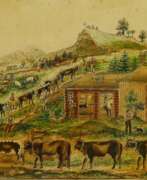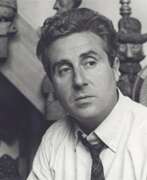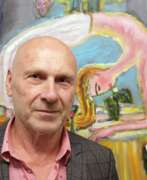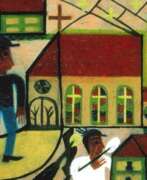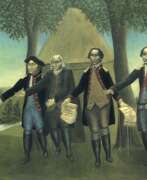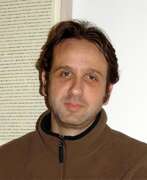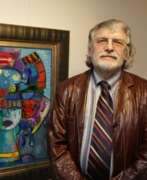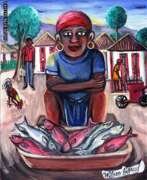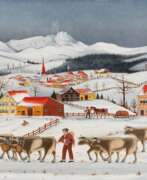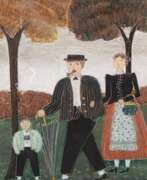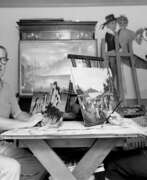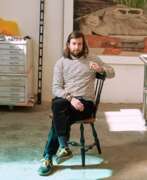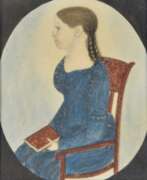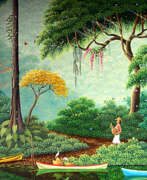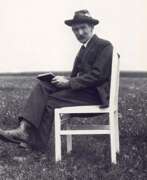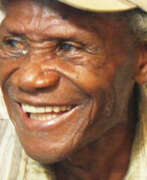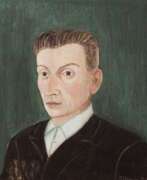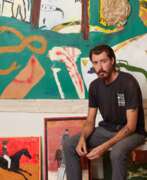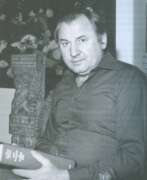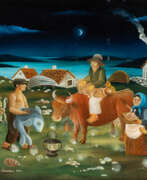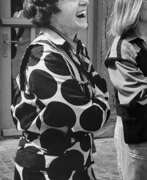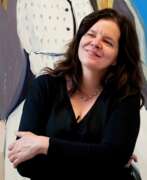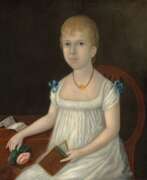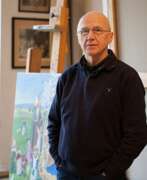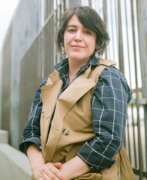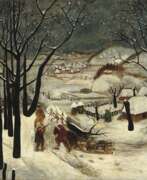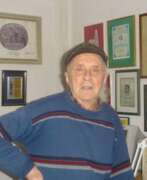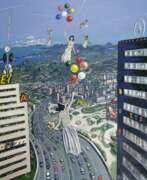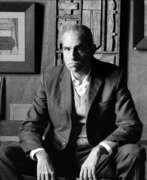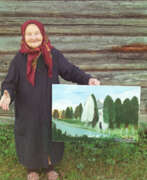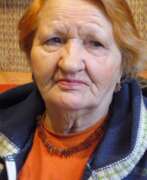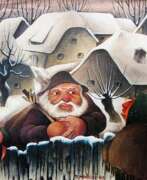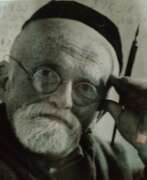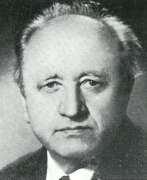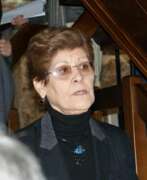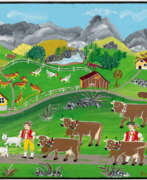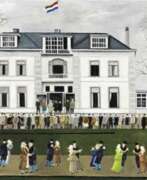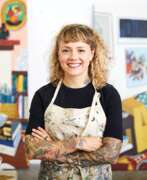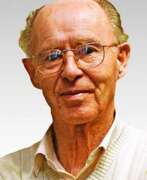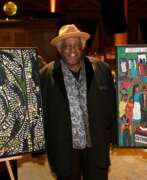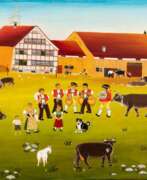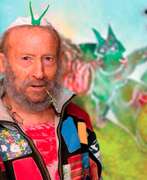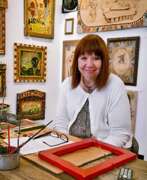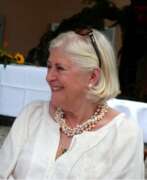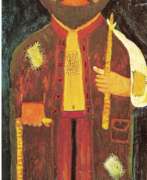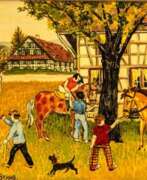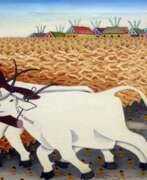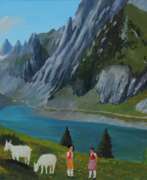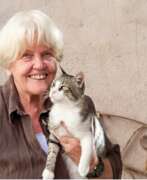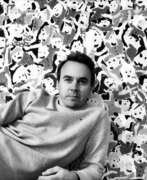Painters Naïve art
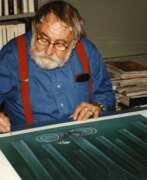

Jan Balet was a German/US-American painter, graphic artist and illustrator. Affected by the style naive art he worked particularly as a graphic artist and as an Illustrator of children's books. Besides this he painted pictures in the style of naive art. Referred to as a "naïve" painter, his works exhibit a dry wit and refreshingly candid, satirical view of life.
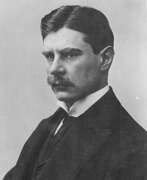

Hans Baluschek, full name Alphons Anton Alexander Hans Ernst Karl Maria Baluschek, was a German painter, graphic artist and writer, representative of the New Materiality style.
Baluschek studied at the Royal Academy of Arts, and in 1900 became a member of the Berlin Secession, a group of artists that also included Ernst Barlach, Max Beckmann, and Wassily Kandinsky. Baluschek was always socially critical, which was reflected in the subjects of his paintings. Many of his paintings are dedicated to the working class of Berlin, he addressed the gray everyday life of Berlin: gray air, gray walls, gray people. Baluschek is often categorized as a German Expressionist because of his emotional style, but his style has something of New Objectivity, Impressionism, and naive painting. He also drew illustrations for the popular children's book Little Peter's Trip to the Moon, and collaborated with periodicals as an illustrator.
World War I instilled patriotic feelings in Baluschek, and he painted a number of subjects on this theme. After the war, he joined the Social Democratic Party and became involved in labor movements. In 1926 he helped establish an artists' relief fund and later became director of the annual Berlin Exhibition. The German Nazis, who came to power in 1933, declared Baluschek a Marxist and a "degenerate artist," suspended him from all positions, and banned him from exhibiting.
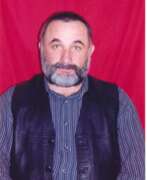

Issa Abasovich Barkhanoyev (Russian: Исса Абасович Барханоев) was a Soviet and Russian Ingush artist of the last quarter of the twentieth and early twenty-first centuries. He is known as a painter, draughtsman, landscape painter, genre painter and poet, a self-taught artist.
Issa Barkhanoyev created more than 500 paintings during his career, in which, according to critics, he skillfully conveyed his deep thoughts and feelings through images and symbols, and these works of art epitomize spirituality and life philosophy. The works of the folk artist are in museums of the Republic of Ingushetia and private collections.
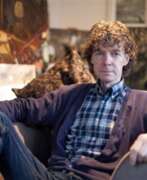

Gary Bunt is a British self-taught artist known for his paintings of the English suburbs and countryside. He took up art to overcome a serious illness. Gary Bunt in a primitive style, with sophisticated simplicity and good humor depicts ordinary life with its simple joys.
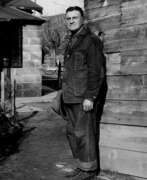

James Castle was an American artist born in Garden Valley, Idaho. Although Castle did not know about the art world outside of his small community, his work ran parallel to the development of 20th-century art history. His works have been collected by major institutions. The Philadelphia Museum of Art organized a retrospective of Castle's work which toured nationally in 2008-09. Castle's work entered the international arena with a major exhibition in Madrid, Spain at the Museo Nacional Centro de Arte Reina Sofía in 2011 and was included in the 2013 Venice Biennale exhibition The Encyclopedic Palace. In 2014 The Smithsonian American Art Museum featured their recent acquisition in the exhibition Untitled: The Art of James Castle and the Whitney Museum of American Art included their acquired collection of Castle's work in the 2017 exhibition Where We Are.
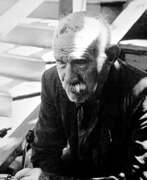

Henry Joseph Darger was an American writer, novelist and artist who worked as a hospital custodian in Chicago, Illinois. He has become famous for his posthumously discovered 15.145-page fantasy novel manuscript called The Story of the Vivian Girls, in What Is Known as the Realms of the Unreal, of the Glandeco-Angelinian War Storm, Caused by the Child Slave Rebellion, along with several hundred drawings and watercolor illustrations for the story.
The visual subject matter of his work ranges from idyllic scenes in Edwardian interiors and tranquil flowered landscapes populated by children and fantastic creatures, to scenes of horrific terror and carnage depicting young children being tortured and massacred. Much of his artwork is mixed media with collage elements. Darger's artwork has become one of the most celebrated examples of outsider art.
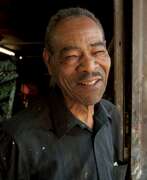

Thornton Dial was a pioneering American artist who came to prominence in the late 1980s. Dial's body of work exhibits formal variety through expressive, densely composed assemblages of found materials, often executed on a monumental scale. His range of subjects embraces a broad sweep of history, from human rights to natural disasters and current events. Dial's works are widely held in American museums; ten of Dial's works were acquired by the Metropolitan Museum of Art in 2014.
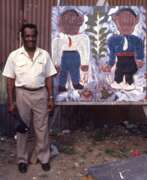

Arthur Dial is an American painter and sculptor living and working in Bessemer, Alabama. He is a part of the Dial family of artists, which include his older brother, Thornton Dial, and his nephews, Thornton Dial Jr., Richard Dial, and Ronald Lockett.
Dial created reliefs and paintings that narrowed in on a specific moment within the broader narrative that he wished to convey. He uses these moments, such as Eve reaching for the forbidden fruit or "George Wallace blockading the entrance to the University of Alabama in Montgomery," to highlight historical or folkloric moments of extreme tension. Dial's focus on scenes of conflict in humanity's real or imagined history come from his direct observation of southern life throughout the 20th century. He describes his narratives as "a record of what went by".
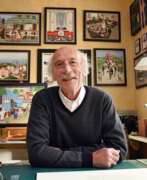

Henry Dieckmann was a German self-taught painter known for his genre naive paintings.
After World War II, Dieckmann worked at the German Federal Railroad factory in Verden and observed life around him. His paintings are imbued with nostalgia for the recent past; they illustrate the everyday life of ordinary people in their spare time with typical European cityscapes.
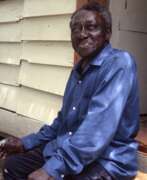

Thomas "Sam" Doyle was an African-American artist from Saint Helena Island, South Carolina. His colorful paintings on sheet metal and wood recorded the history and people of St. Helena’s Gullah community.
Doyle's paintings and sculptures are held in the permanent collections of American Folk Art Museum, the High Museum of Art, the Smithsonian American Art Museum, the Gibbes Museum of Art and the Los Angeles County Museum of Art and Penn Center (Penn School on St. Helena Island).


Marcel Dzama is a contemporary artist from Winnipeg, Manitoba, Canada who currently lives and works in New York City. His work has been exhibited internationally, in particular his ink and watercolor drawings. Dzama works extensively in sculpture, painting, collage, and film. The artist is also known for his intricate dioramas and large scale polyptychs that draw from his talents across a range of media. Dzama works in multiple disciplines to bring his cast of human figures, animals, and imaginary hybrids to life, and has developed an international reputation and following for his art that depicts fanciful, anachronistic worlds.
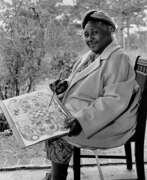

Minnie Eva Evans was an African American artist who worked in the United States from the 1940s to the 1980s. Evans used different types of media in her work such as oils and graphite, but started with using wax and crayon. She was inspired to start drawing due to visions and dreams that she had all throughout her life, starting when she was a young girl. She is known as a southern folk artist and outsider artist as well as a surrealist and visionary artist.


Madge Gill was a British artist.
Gill was born into a large family and was raised in poverty. She suffered from various health problems throughout her life, including blindness in one eye and later the loss of her son, which led her to experience bouts of depression.
Despite her challenging circumstances, Gill was a prolific artist, creating thousands of drawings and embroideries over the course of her life. Her work was often inspired by spiritualism and included intricate and highly detailed patterns and symbols.
Gill's work was first discovered by chance in 1963, two years after her death. Her work has since been exhibited in major galleries and museums around the world, including the Hayward Gallery in London and the American Folk Art Museum in New York City.
Today, Gill is considered an important figure in the history of outsider art and is celebrated for her unique and distinctive style. Her work continues to inspire and captivate art lovers and collectors around the world.
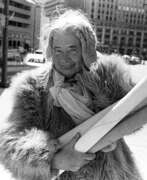

Lee Godie (born Jamot Emily Godee) was an American self-taught artist who was active in Chicago during the late 1960s until around the early 1990s. She was a prolific artist who was known for her paintings and modified photos which are shown in galleries and museums such as the Hayward Gallery in London and the Smithsonian American Art Museum. She is often considered Chicago's most collected artist.
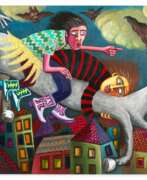

Oska Gutheil is a German painter. Oska Gutheil is regarded as a new star in the art world: galleries in metropolises such as New York, Berlin and Vienna are vying for the artist's pictures, who combine naïve painting with punk and comic elements. Oska Gutheil creates colourful, crazy worlds full of hybrid creatures – and with it his own biography.

Hector Hyppolite was a Haitian painter. Considered as the "Grand Maître of Haitian Art".
Hyppolite, a prolific painter, typically depicted Vodou scenes and created between 250 and 600 paintings during the last three years of his life. Much of his work was influenced by his devotion to his work as a priest.


John Kane was an American painter celebrated for his skill in Naïve art.
He was the first self-taught American painter in the 20th century to be recognized by a museum. When, on his third attempt, his work was admitted to the 1927 Carnegie International Exhibition, he attracted considerable attention from the media, which initially suspected that his success was a prank. He inadvertently paved the way for other self-taught artists, from Grandma Moses to Outsider Art. Today Kane is remembered for his landscape paintings of industrial Pittsburgh, many of which are held by major museums such as the Museum of Modern Art, Carnegie Museum of Art, Whitney Museum of American Art, and the Metropolitan Museum of Art.
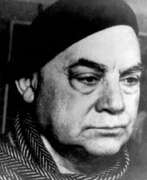

Iosif Artemievich Karalyan was a Soviet artist, member of the USSR Union of Artists and Honoured Artist of the Armenian SSR.
Karalyan's creative work is a kind of nostalgia for the country of childhood, which you can visit only in dreams and imagination, as it no longer exists, because childhood of every person, like his era, is unique, the unrepeatable sensations experienced, they are preserved visually only in the fine arts.
His works are kept in the Museum of Modern Art (Yerevan), National Gallery of Armenia (Yerevan), State Tretyakov Gallery (Moscow), Museum of Oriental Art (Moscow), home-museum of Hovhannes Tumanyan (Yerevan), the funds of the Ministry of Culture of Armenia and numerous private collections in Armenia and abroad.


Franjo Klopotan is a Croatian surrealist painter.
Klopotan is considered a master of naive art in postwar Croatia. He began painting in 1959 and had his first solo exhibition in Zagreb in 1963. Later, during his stay in Germany, participating in exhibitions, he gained international fame.
Franjo Klopotan is a painter of waking dreams, bringing elements of surrealism and popular fantasy into his work.
Klopotan was a member of the Croatian Society of Naive Artists, the Croatian Society of Fine Artists and the Association of Croatian Artists.


Boris Nikolaevich Koshelokhov, known in artistic St. Petersburg under the nickname Bob, was a Soviet and Russian avant-garde artist.
Boris Koshelokhov was the organiser of a group of non-conformist artists called "Letopis", which represented an extremely heterogeneous spectrum of directions: from extreme expressionism to primitivism.


Nikifor Krynicki, born as Epifaniy Drovnyak, was a Lemko naïve painter. Nikifor painted over 40,000 pictures – on sheets of paper, pages of notebooks, cigarette cartons, and even on scraps of paper glued together. The topics of his art include self-portraits and panoramas of Krynica, with its spas and Orthodox and Catholic churches. Underestimated for most of his life, in his late days he became famous as a naïve painter.
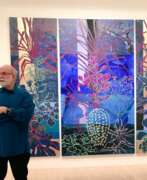

Robert Kushner is an American contemporary painter who is known especially for his involvement in Pattern and Decoration. He has been called "a founder" of that artistic movement. In addition to painting, Kushner creates installations in a variety of mediums, from large-scale public mosaics to delicate paintings on antique book pages.
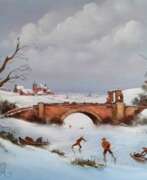

Jean-Marie Lamare is a Flemish primitive painter of today, a rare master of tempera. This technique inherited from the great Flemish Masters surprises with its particular luminosity. The compositions of J. M. Lamare transport us to a fantastic world.


Judith Linhares is an American painter, known for her vibrant, expressive figurative and narrative paintings. She synthesizes influences including Expressionism, Bay Area Figuration, Mexican modern art and second-wave feminism, in work that flirts with abstraction and balances visionary personal imagery, expressive intensity, and pictorial rigor. In the early 1970s, Linhares created narrative drawings and assemblages that appropriated commonplace or "craft" materials and feminine imagery (flowers, eggs, swan feathers, domestic scenes). After 1980 she developed a Symbolist allegorical world of enigmatic, bulbous-headed creatures, narcoleptic nudes, phantasms, figures in boats, and human metamorphosis. Her fantastic imagery was balanced by lush color, painterly sensual surfaces, and sure design. Through the 1990s, critics noted in her work a sunnier palette, increasingly abstract and ambiguous imagery, and a growing facility with a naïve drawing style. In the 2000s, Linhares has turned to female nudes (often monumental), visionary landscapes, floral still lifes and animals. Linhares has been recognized with more than forty-five one-person exhibitions and major awards from the American Academy of Arts and Letters and John Simon Guggenheim Memorial Foundation.
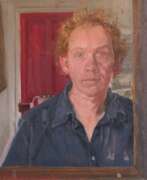

Frederick James Lloyd was an English artist. He became famous for his paintings, mostly of animals and country landscapes.
He was the first living self-taught artist to have a painting hung at the Tate in London, titled Cat and Mouse.


Gilbert Lujan was an American sculptor and muralist. He is better known in professional circles under the pseudonym "Magu".
Magu's work became popular throughout the 1980s and 1990s for its use of colourful imagery, anthropomorphic animals, lowrider images of outrageously proportioned sizes, decorated with overlapping indigenous motifs (cities, graffiti), Dia De Los Muertos installations, altars and all manner of pop culture borrowings.
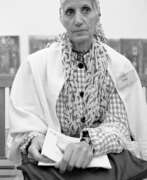

Baya Mahieddine (Arabic: باية محي الدين) or Fatima Haddad (Arabic: فاطمة حداد) was an Algerian artist who is best known for her vibrant and colorful paintings that often featured bold shapes and figures. At the age of sixteen Baya had her first exhibition, in Paris, where she gained notice from renowned artists such as Pablo Picasso and André Breton.
Baya's work is often associated with Surrealism, as she was heavily influenced by Breton and other Surrealist artists. However, she also drew inspiration from traditional Algerian art and culture, incorporating elements such as calligraphy and geometric patterns into her work.
Throughout her career, Baya's work was exhibited in Algeria and France, and she received widespread critical acclaim for her unique style and approach to painting. In addition to her paintings, she also created tapestries, ceramics, and other works of art.


Salomon "Sal" Meijer was a Dutch painter, primarily known for his paintings of cats and Amsterdam city views. Works by Meijer are on view at the Jewish Historical Museum and the Kattenkabinet cat museum in Amsterdam, among others. In his youth, he worked in the diamond industry while studying art. He devoted himself full-time to painting in 1914. His first one-man exhibition was in 1926. Meijer's work was included in the 1939 exhibition and sale Onze Kunst van Heden (Our Art of Today) at the Rijksmuseum in Amsterdam. Due to the simplicity of Meijer's paintings and his modest attitude - he did not regard his paintings as works of art but as craftmanship - his work was often labeled as "naive" and "primitive". However, a re-evaluation of his work began in 1957 with the article by Kasper Niehuis.
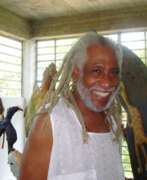

Manuel Mendive Hoyos is one of the leading Afro-Cuban artists to emerge from the revolutionary period, and is considered by many to be the most important Cuban artist living today.
Mendive's work incorporates several art mediums and genres. His art consists of drawing, painting, body painting, wood carving, sculpture, and performance that integrates loosely choreographed dance with rhythmic music.
Mendive's art is strongly influenced by the Santería religion. In fact, Santería permeates every form of his art from body painting to events performed in public spaces.
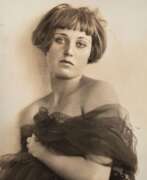

María del Carmen Mondragón Valseca, also known by her pen name Nahui Olin, was a Mexican artist, model and poet.
Carmen Mondragon was associated with the avant-garde movement, known for her unconventional lifestyle and outspoken nature. Her contributions to Mexican modernism and her role as muse to famous artists and writers further cemented her status as a cultural icon.
Nahua Olin's personal life and relationships were equally unconventional. She had affairs with famous artists, including Diego Rivera and Gerardo Murillo (Dr Atl), which influenced her artistic expression and worldview. Her exploration of love, desire and identity through her art and personal experiences has made her a symbol of female empowerment and sexual liberation.
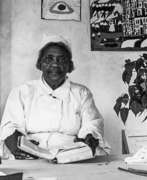

Sister Gertrude Morgan was a self-taught African-American artist, musician, poet and preacher. Sister Morgan achieved critical acclaim during her lifetime for her folk art paintings. Her work has been included in many groundbreaking exhibitions of visionary and folk art from the 1970s onwards.
Similar to other self-taught artists, Sister Morgan used simple forms to depict the human figure. Her works are characterized by their lack of the use of formal techniques such as perspective and definition of light and shadow, giving them a flat, two dimensional quality. She painted and drew using acrylics, tempera, ballpoint pen, watercolors, crayon, colored and lead pencils and felt tip markers. Using inexpensive materials she had at hand, Sister Morgan painted on paper, toilet rolls, plastic pitchers, paper megaphones, scrap wood, lampshades, paper fans and styrofoam trays. The fact that she was self-taught, coupled with her choice of materials as well as her style and subject matter have led her to be characterized as a naive, folk, visionary, vernacular and outsider artist.


Curt Mühlenhaupt was a German artist He was a prominent figure in the post-World War II art scene in Berlin and is known for his distinctive style that combined elements of figurative and abstract art.
Mühlenhaupt's work often depicted the everyday life of Berliners, especially those living in the working-class neighborhoods of the city. He was interested in the contrast between the dilapidated and gritty aspects of the city and the resilience and humor of its inhabitants. His paintings and drawings were characterized by bold, thick brushstrokes and a vibrant use of color.
In addition to his paintings and drawings, Mühlenhaupt was also known for his work in other mediums, such as printmaking and photography. He was a prolific artist, producing a large body of work over the course of his career.
Today, Mühlenhaupt's work is held in collections around the world, including the Berlinische Galerie and the Museum of Modern Art in New York.
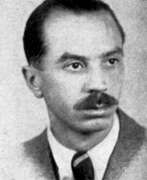

István Pekáry is a Hungarian painter, graphic artist, scenographer and textile designer.
István trained at the Budapest Academy of Fine Arts, then studied in Rome for several years. He painted in oils, designed tapestries, sets and frescoes. In 1936, Pekary founded a weaving workshop in Buda, where he created tapestries inspired by folk art. Between 1933 and 1962, in Hungary and abroad, he designed set and costume designs for several theater and opera productions (Municipal Theater, National Theater, Schiller Theater in Berlin, Teatro del Opera in Rome; Staatsoper in Vienna).
Istvan Pekary's work is characterized by the deliberate naivety of the fairytale world. However, this deliberate primitiveness is not a superficial influence of folklore, but has its roots in the artist's exploration of folk art. The technique of using colors is characteristic of eggshell painting.


Horace Pippin was an African-American artist of the second quarter of the twentieth century. He is known as a self-taught artist who painted in the style of naive art.
Pippin painted in a variety of genres, from landscapes and still lifes to biblical subjects and political statements. Some of his work draws on personal military and family experiences, with subjects inspired by Pippin's service in the Army during World War I and the history of slavery and racial segregation in the United States.


Niko Pirosmani was a Georgian primitivist painter, known for his unique approach to art, marked by simplicity and directness. Born in 1862 in the village of Mirzaani, Georgia, Pirosmani was largely self-taught, developing his skills through his work as a signboard painter. His early life was marked by hardship; orphaned at a young age, he took on various jobs, such as a railroad conductor and dairy farm co-founder, to sustain himself. Despite his financial struggles, Pirosmani's dedication to painting persisted.
Pirosmani's work, characterized by its naïve style, often depicted rural life, animals, and historical Georgian figures. His medium of choice was typically oilcloth, and he preferred frontal placements of figures and monochromatic palettes. His work gained posthumous fame, influencing the Russian avant-garde. Pirosmani's life, filled with both adversity and creative triumph, ended in 1918 due to malnutrition and liver failure, leaving behind a legacy that continues to resonate within the art world.
One of his notable works, "Wedding in the Old-Times Georgia" (1916), showcases his appreciation for Georgian customs and is considered a turning point in his career. Another significant piece, "Portrait of Ilya Zdanevich" (1913), exemplifies his style and the influence of his meeting with the Zdanevich brothers, which brought his art to a wider audience. Pirosmani's paintings are housed in institutions like the Art Museum of Georgia in Tbilisi, reflecting his enduring impact on Georgian culture.
Collectors, auctioneers, and art experts continue to revere Pirosmani's work for its raw and emotive power. His pieces, once overlooked, now fetch high prices at auctions and are studied for their cultural and historical significance. For those interested in Pirosmani's art and legacy, updates on new product sales and auction events related to his work are available through subscription. This service provides enthusiasts with timely information, ensuring they don't miss out on the opportunity to engage with the profound artistry of Niko Pirosmani.


Maria Oksentiyivna Prymachenko (Russian: Мария Авксентьевна Примаченко) was a Soviet and Ukrainian artist of the twentieth century. She is known as a bright representative of primitivism. Self-taught Maria Prymachenko painted more than 800 paintings during her long life.
Maria Prymachenko drew inspiration from folk folklore and filled her works with symbolic content. She achieved international recognition early on, but refused to move to the capital and lived all her life in her native village. In addition to painting, the artist was fond of embroidery and painted ceramics, as well as illustrated books by Ukrainian writers and poets.
People's Artist was in favor of the authorities. She was awarded with numerous honorary titles, orders and medals. Maria Prymachenko was constantly visited by well-known cultural workers. Her paintings were constantly exhibited at international exhibitions. Most of Prymachenko's paintings are now kept in the National Museum of Ukrainian Decorative Folk Art.


Jaune Quick-to-See Smith is a Native American visual artist and curator.
She is also an art educator, art advocate, and political activist. She has been prolific in her long career, and her work draws from a Native worldview and comments on American Indian identity, histories of oppression, and environmental issues.
In the mid-1970s, Smith gained prominence as a painter and printmaker, and later she advanced her style and technique with collage, drawing, and mixed media. Her works have been widely exhibited and many are in the permanent collections of prominent art museums.


Eun Nim Ro is a South Korean artist who has worked in Germany.
She moved to Germany as a nurse in 1970, where she had the opportunity to exhibit her first works and receive art education. Eun Nim Ro developed an intuitive style of painting that combined Korean brush and ink drawings with the expressiveness of Western art. Naively drawn signs of fish, birds, trees and human figures became the artist's symbols. Eun Nim Ro's creative work is not limited to painting, she has also worked in other disciplines such as performance, calligraphy, painting, ceramics or installation. She has designed the windows of St. Johannes Church in Altona, among others, as well as light walls for government buildings in Seoul.
In 1990, Eun Nim Ro took up a professorship at the Hamburg University of Applied Sciences. In 1995, the artist became an honorary citizen of Seoul, and in 2015 she was also awarded the title of professor in Korea.
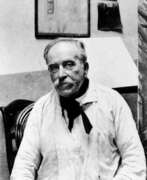

Henri Rousseau was a remarkable French painter, whose work continues to captivate art collectors and experts. Born in Laval, France, in 1844, Rousseau's artistic journey was unconventional. He began painting later in life, around the age of forty, and was primarily self-taught. Despite a lack of formal training, Rousseau developed a unique style that set him apart in the art world.
Rousseau's paintings, characterized by their rich colors and detailed depiction of jungle scenes, wild animals, and exotic figures, marked him as the archetype of the modern naïve artist. He regularly exhibited at the Salon des Indépendants from 1886, gaining attention and admiration over time, especially for works like "Tiger in a Tropical Storm (Surprised!)" and "The Sleeping Gypsy". His art was distinctive for its dreamlike quality and its blend of fantasy and reality.
In 1905, Rousseau exhibited "The Hungry Lion Throws Itself on the Antelope" at the Salon des Indépendants, alongside works by avant-garde artists such as Henri Matisse, marking the first showing of The Fauves. This exhibition was a significant moment, as it highlighted Rousseau's influence on and connection with contemporary art movements. His work, particularly his jungle scenes, was a precursor to surrealism, seen in later artists like René Magritte.
Rousseau's art also included suburban landscapes of Paris, offering a tranquil and cultivated view of the city in contrast to the emotionally charged jungles. These works often included modern elements like smokestacks and telephone poles, yet maintained an eerie stillness, making the familiar appear strange.
A notable event in Rousseau's life was the banquet held in his honor by Pablo Picasso in 1908, an event that signified Rousseau's growing recognition and influence in the art world. This gathering was attended by many influential artists and writers of the time.
Rousseau continued to paint until his death in 1910. His final painting, "The Dream", was exhibited in the same year. Today, Rousseau's works are celebrated for their originality and imaginative quality, and can be found in major museums and galleries worldwide.
For art collectors and experts, Rousseau's work represents a unique blend of naïve art and modern artistic movements. His influence on subsequent artists and his distinct style make his paintings a valuable addition to any collection.
Stay updated on new discoveries and sales related to Henri Rousseau by signing up for our updates. Please note, this subscription is specifically for alerts on new product sales and auction events related to Henri Rousseau.
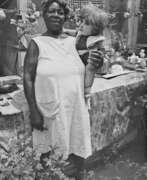

Nellie Mae Rowe was an African-American artist from Fayette County, Georgia. Although she is best known today for her colorful works on paper, Rowe worked across mediums, creating drawings, collages, altered photographs, hand-sewn dolls, home installations and sculptural environments. She was said to have an "instinctive understanding of the relation between color and form." Her work focuses on race, gender, domesticity, African-American folklore, and spiritual traditions.
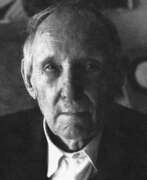

Sava Sekulić was a Serbian Naïve and Outsider art painter.
Sekulić is a painter of the universal, the timeless, and the limitless. For him, everything is generalized, from the individual he aspires to the universal, and is very successful. Therefore, his works are the highest achievements of L'art brut, not only in the country but worldwide. Allegories and metaphors are present in nearly all his works. With his visions, he reduced a unique pictorial definition, minimized the subject matter to a metaphor. Most numerous are his compositions with human figures, portraits and scenes with historical and beings. While painting historical personalities, he portrayed the victims as heroes, and the members of his family as mythological beings. However, the most complex is the figure of a woman.
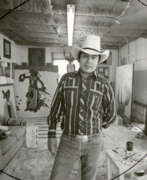

Tommy Wayne Cannon, also known as T. C. Cannon, was a 20th century American Indian artist.
In his work, T. C. Cannon often addressed themes of Native American identity, culture, and the impact of colonisation. He conveyed powerful messages of social and political significance in his paintings and prints.
Cannon's works are characterised by vivid colours, bold compositions and profound storytelling, leaving an indelible mark on the art world.
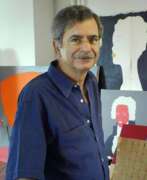

Ernesto Tatafiore is an Italian artist, one of the forerunners of the Italian Transavantgarde that emerged in the early 1980s.
Naples, where Tatafiore's studio is located and which is a favorite place for his work, has a decisive influence on his work. Vesuvius is an obsessive image of the artist and a source of his inspiration. The theme of the French Revolution is also a recurring theme in his work.
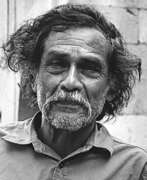

Francisco Benjamín López Toledo was a Mexican Zapotec painter, sculptor, and graphic artist. In a career that spanned seven decades, Toledo produced thousands of works of art and became widely regarded as one of Mexico's most important contemporary artists. An activist as well as an artist, he promoted the artistic culture and heritage of Oaxaca state. Toledo was considered part of the Breakaway Generation of Mexican art.
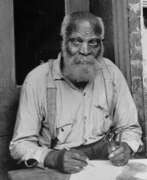

William Traylor was an African-American self-taught artist from Lowndes County, Alabama. Born into slavery, Traylor spent the majority of his life after emancipation as a sharecropper. It was only after 1939, following his move to Montgomery, Alabama, that Traylor began to draw. At the age of 85, he took up a pencil and a scrap of cardboard to document his recollections and observations. From 1939 to 1942, while working on the sidewalks of Montgomery, he produced nearly 1 500 pieces of art.
While Traylor received his first public exhibition in 1940, it was not until 30 years after his death that his work finally began to receive broader attention, in the late 1970s. Recent acceptance of Traylor as a significant figure of American folk and modern art has been founded on the efforts of Charles Shannon, as well as the evolving tastes of the art world. Shannon, who first encountered Traylor's work in 1940, brought Traylor to the attention of the larger art world. Traylor now holds a central position in the fields of "self-taught" and modern art.
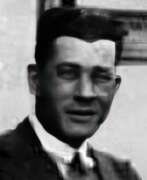

Miguel García Vivancos was a Spanish Naïve painter and anarchist. He was a member of the National Confederation of Labor (Spanish: Confederación Nacional del Trabajo, CNT), during the Spanish Civil War he commanded several military units. With the defeat of the Republic he went into exile, where he developed a career as a painter. He was artistically known by his second surname.
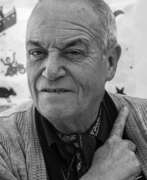

Raymond-Émile Waydelich is a French-Alsatian painter, sculptor and action artist. He lives and works in Hindisheim/Alsace.
Waydelich's extensive oeuvre includes paintings, sculptures and sculptures in ceramic or bronze, assemblages, works on paper as well as public art actions and performances. The artistic techniques of his colourful, playful, witty and whimsical graphics range from drawing, watercolour, lithography, etching and monotype to overpaintings of found paper objects.
He is one of France's best-known living artists. His works are in numerous public and private collections worldwide. His watercolour collages have become particularly famous, showing real-life creatures (crocodile, cat, pig) ghostly alienated within landscapes, which the artist painted on antique letters, some of which he acquired on journeys (e.g. to Crete). His style, which often takes up perspectives, motifs and elements of prehistoric cave paintings or Greek mythology, approaches fantastic realism.
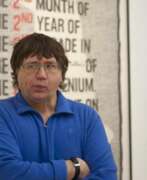

George Widener is a self-taught artist who employs his mathematical/calculating capability to create art ranging from complex calendars and numerical palindromes to Rembrandt-like antiquarian landscapes to Asian scrolls.
Widener's work can be found in many private and public Outsider Art collections, including the Bruno Decharme ABCD Collection in Paris, The American Folk Art Museum, The Art Collection of the UC Davis M.I.N.D. Institute, and The Collection de l’Art Brut.
